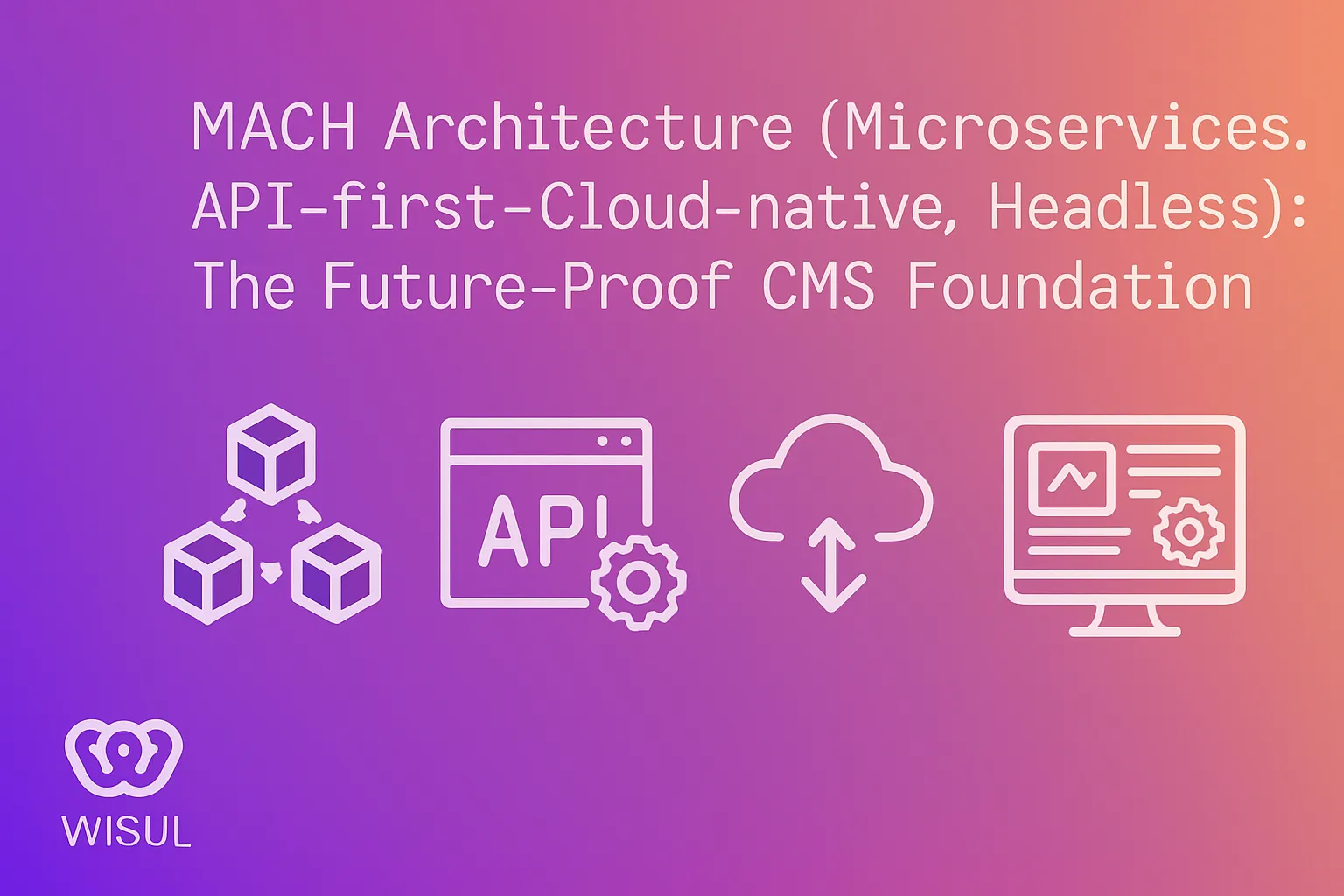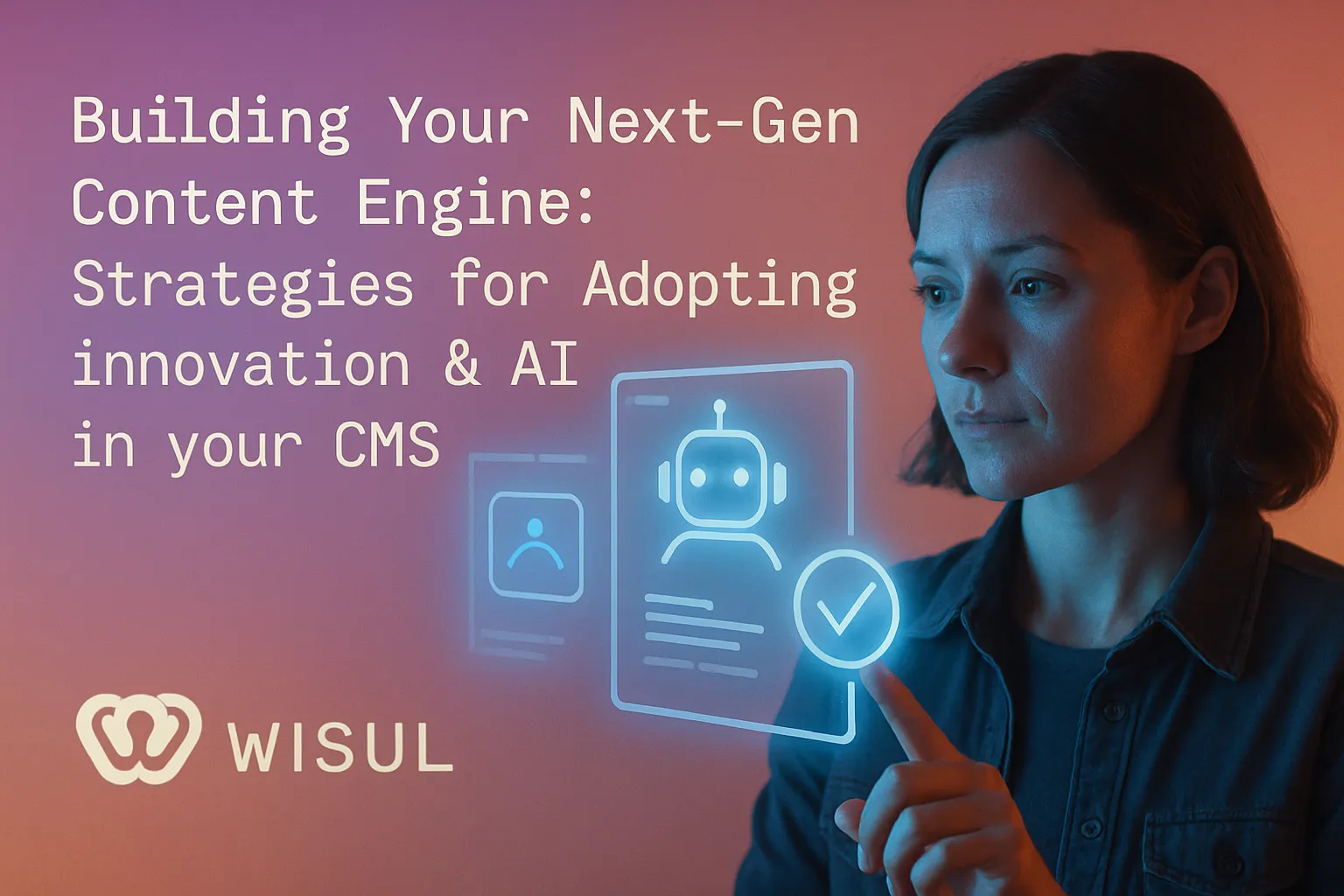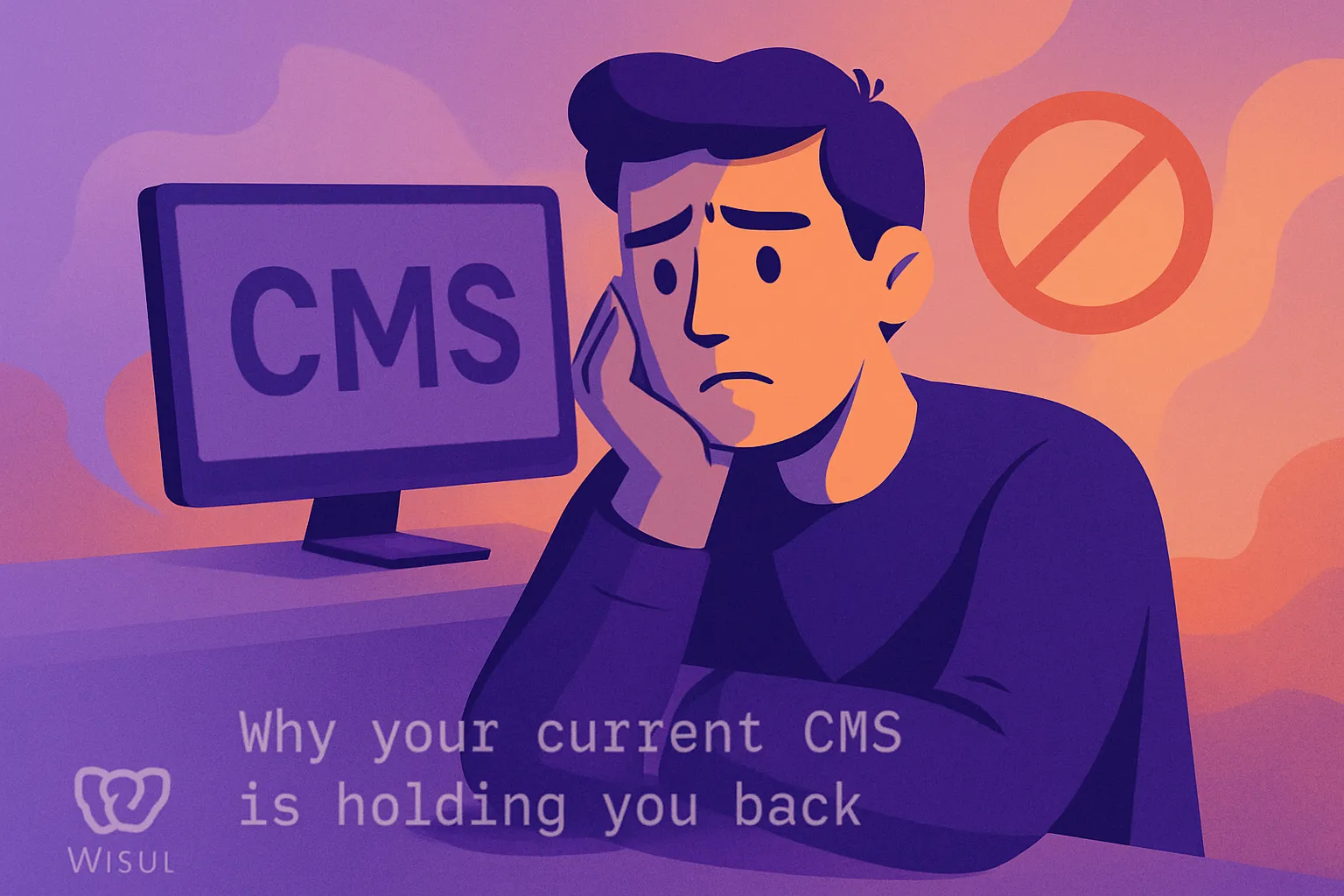- Key Takeaways
- What is MACH Architecture?
- MACH vs. Monolithic CMS
- The Business Case for MACH
- Navigating the MACH Transition
- The Developer’s Perspective
- Securing Your Composable Future
- Conclusion
- Frequently Asked Questions
- What is MACH architecture in CMS?
- How does MACH architecture differ from monolithic CMS?
- What are the main business benefits of MACH CMS?
- What challenges might companies face when moving to MACH?
- How does MACH architecture impact developers?
- Is MACH architecture more secure than traditional CMS?
- Can MACH CMS work for small businesses?
Key Takeaways
- MACH architecture (Microservices, API-first, Cloud-native and Headless) to content management.
- By embracing MACH, businesses can innovate rapidly, adapt to market changes, and provide tailored experiences across all digital touchpoints.
- Microservices and API-first help enable fast product development, easy integration, and better cross team collaboration, all of which decrease the time-to-market for new features.
- Cloud-native and headless architectures enable effortless scaling, high availability, and constant updates, empowering systems to be resilient and future-proof.
- Moving to MACH is not trivial – it demands thoughtful planning, change management and an integration roadmap in order to navigate pain points like system compatibility and workforce preparedness.
- Organizations gain increased agility, cost effectiveness, and long-term competitive advantage through MACH’s composable and secure architecture.
Mach architecture cms refers to a content management system built with commerce proven microservices, API-first, cloud-native and headless architecture. Brands leverage this architecture to decouple content, services and front-ends for enhanced speed and scale.
Mach CMS makes teams ship faster, add new capabilities and deliver to users across devices. For many global firms, mach is their pick for easily updated and robust multi-site support.
The following sections illustrate how mach cms operates and why it’s important.
What is MACH Architecture?
MACH Architecture is a new way to build digital systems that prioritizes flexibility and modularity. It’s a design style made up of four main parts: Microservices, API-first, Cloud-native, and Headless. Each bit operates independently but collaborates excellently with the rest, facilitating the application of best-of-breed tools to every task.
By segmenting the customer experience into individual microservices, MACH enables teams to construct, modify, and scale digital products more quickly and with reduced risk. This method suits companies that must launch new functions, experiment with concepts, or address shifts in business requirements without large renovations to the entire system.
With MACH, you get velocity, composability, and simple repair, which makes it a compelling option for anyone who wants high performance, future-proof architectures. It enables teams to deliver richer user experiences by allowing them to customize content and functionality for different devices and users.
1. Microservices
Microservices are tiny focused services that function independently but can connect to others. Each one does one job, which makes creating, repairing, and refreshing apps simpler. This division allows teams to develop various sections simultaneously, allowing updates to be deployed more rapidly.
They converse with lightweight protocols like HTTP APIs, so there’s less bloat and more speed. If a new requirement arises or an existing functionality requires a patch, just that microservice is updated. This provides teams the flexibility to modify, replace functionality, or introduce new capabilities without disrupting the remainder of the platform.
2. API-First
In an API-first architecture, teams begin by building APIs, not the front end or back end. This guarantees every capability is accessible or integrates with other solutions from the beginning.
It implies the front end is free to evolve, as it merely must interface with the API. This process minimizes team confusion and keeps work flowing. APIs make it simple for teams to collaborate and integrate with external partners.
3. Cloud-Native
Cloud-native apps are designed to take advantage of key features of cloud hosting such as rapid scaling and regular updates. Teams can respond to additional users or additional work by increasing resources immediately, without scheduling months in advance.
Cloud services provide high uptime and rapid remediation if something goes awry. New features can roll out fast, and updates can happen all the time, not just once a year. This keeps the elephants dancing.
4. Headless
Headless means the content management is not bound to a single front end. The back end is where the data lives, and the front end can be anything—sites, apps, wearables.
Content teams can publish updates a single time and it will appear wherever the company requires. This provides them additional flexibility to craft communications for each platform or audience.
They don’t need to wait for tech teams to update. The end result is a superior user experience, as content conforms to both needs and devices.
MACH vs. Monolithic CMS
MACH vs. Monolithic CMS platforms follow different approaches to handle content and operate digital experiences. MACH is an acronym for Microservices-based, API-first, Cloud-native and Headless. It fragments systems into small, independent components.
Monolithic CMS guards everything closely—features, content, and logic are all bound tightly in lock and key. This is why a direct comparison is helpful to teams evaluating their long-term needs and risks.
Feature/Metric | MACH Architecture | Monolithic CMS |
|---|---|---|
Structure | Modular, each part stands alone | All-in-one, tightly linked |
Scalability | Scale each part as you need | Whole system must scale together |
Updates | Update single parts with less risk | Updates often disrupt whole system |
Deployment Speed | Faster, smaller parts roll out quickly | Slower, big releases, more checks |
Flexibility | Add or swap parts easily | Hard to add or change parts |
Integration | Open to outside tools via APIs | Harder to connect to new tools |
Downtime Risk | Low, issues stay in one part | High, issues can break everything |
Best-of-Breed Support | Yes, easy to mix top tools | No, often locked to built-in tools |
Example | Use Stripe for payments, Algolia search | All features from one vendor |
Scaling is one of the biggest challenges with monolithic systems. You must scale the entire monolithic CMS, even if only a single feature requires additional horsepower, which results in waste and increased expenses.
MACH allows you to scale each component individually, enabling you to scale to demand without excess. Updating is easier, too. With MACH you can deploy changes to one component, such as the search bar, without endangering the checkout process.
Monolithic systems require larger, riskier updates that can cause downtime. MACH’s best-of-breed approach means companies can pick top tools for search, payments, or analytics.
Monolithic CMS platforms frequently railroad teams into employing out-of-the-box functionality, whether it suits them or not. MACH’s API-first setup makes it super simple to hook up with other channels, like mobile apps or smart devices, giving businesses maximum reach.
The Business Case for MACH

Here’s why MACH architecture is distinctive for businesses that want to keep up with digital change. Combining agility, scale, and future-readiness — like legacy, monolithic systems can’t. The framework is built for those who demand rapid transformation and demonstrable outcomes in CX and business growth.
Benefit Category | MACH Architecture | Traditional Systems |
|---|---|---|
Flexibility | High (modular, composable) | Low (tightly coupled) |
Agility | Rapid feature rollout | Slow release cycles |
Customization | Tailored to business needs | Limited, vendor-driven |
Scalability | On-demand, cloud-native | Often manual, hardware-based |
Future-Proofing | Easy tech upgrades | Risk of obsolescence |
Cost Efficiency | Pay-as-you-go, resource lean | Upfront costs and overprovision |
Customer Experience | Personalized, seamless | Generic, rigid |
Competitive Advantage | Fast to market | Slower response |
Unmatched Flexibility
MACH unlocks for firms limitless technology options. You can mash best-of-breed tools, swapping or introducing new ones with minimal hassle. This implies that when a superior CMS, search, or payment tool is released, you aren’t in line for a full system overhaul.
Instead, you bolt it on. This structure enables teams to mold solutions for their specific demands — whether it’s retail, banking, or media. All this flexibility translates into improved user service.
If you need to get a new feature up quickly, or customize the customer journey for a particular market, MACH enables you to do it. It’s not only about IT; it signifies tangible improvements in customer perception of your brand.
True Scalability
Real scalability with MACH is about scaling apps or services in the cloud to meet demand, not in advance. The platform manages spikes in user traffic, like holiday rush or flash sales, without downtime.
Even as your business grows, your cost stays in check, since you pay for what you consume. Because MACH is cloud-native, juicing up the power and fresh features doesn’t bust the budget.
That keeps your business agile and poised for sustained growth.
Future-Proofing
MACH’s modular architecture means you can plug in new tech like AI, voice, or even AR, without dismantling what already functions. When market trends shift—say, more people buy on mobile—MACH enables you to change direction quickly.
This flexibility protects you from abrupt changes in technology or consumer behavior. It helps your business rebound from disappointments, because nothing is hard-coded or too difficult to adjust.
Cost-Effectiveness
Costs move from large upfront spends to smaller, recurring payments. You don’t pay for idle servers or unused software. Team resources stretch because updates and changes are smaller and more focused.
MACH reduces waste and accelerates team effectiveness, enabling you to concentrate on what counts—amazing products and delighted customers.
Navigating the MACH Transition
Transitioning from legacy systems to MACH architecture is embracing an agile, component-based approach to managing digital experiences. This step is about more than tool swapping—it’s about crafting a future-ready ecosystem that spans markets and touchpoints.
Audit existing tech stack and gaps—search for legacy systems that are decelerating growth or hindering innovation.
Construct a thoughtful business-driven, customer-experience-centric strategy to get ahead in a rapidly evolving digital landscape.
Define your transition roadmap. Include timelines, phased rollouts and checkpoints for review.
Bring important teams—from IT to marketing—in early, to generate buy-in and minimize pushback.
Train staff and hire talent who get composable and cloud-native.
Test integrations and run pilots in low-risk pockets prior to deployment.
Track progress, solicit feedback and revise plans as necessary for continued success.
Common Hurdles
- Pushback from developers and other teams (39% cite this as a primary barrier)
- Uncertain trade-offs between upfront investment and long-term benefits (33% mention this concern)
- Integration issues with old systems and new MACH modules
- Gaps in skilled staff or training for MACH tools
Resistance is always the hardest part, particularly with teams stuck in legacy systems. For instance, an enterprise that relied on a monolithic CMS for years might find it hard to appreciate the benefits of disassembling it, even if that results in speedier changes and less bugs.
Merging legacy and modern systems has its headaches. Each piece has to communicate effectively with the others, or face bottlenecks and data loss.
Teams require the appropriate skills. Inexperience with APIs, microservices, or cloud tools can drag on momentum and inflate costs.
Integration Strategy
- Set clear integration goals and milestones
- Rely on strong APIs for smooth data sharing
- Test early and often for bugs or slowdowns
- Watch and tweak systems as needs shift
APIs are the fuel of MACH integration. They allow platforms, such as e-commerce and content management, to exchange information quickly. Testing says less surprises and prevents errors from propagating throughout systems.
Being out ahead is inspecting and tuning systems constantly. That way, teams catch bugs quickly, release features quickly and adapt to market changes.
Vendor Selection
- Checklist:
- Proven experience with MACH.
- Strong backing and education.
- Business-goals-fitting solutions.
- Devotion to 10-year partner.
Good vendors have more than products. They onboard teams, assist with configurations and provide ongoing support. Their tools have to fit business strategies, not fads.
Companies need to seek partners who think long term. When vendors and clients collaborate, updates and changes arrive quicker and with less hassle.
The Developer’s Perspective

MACH architecture delivers real benefits for CMS developers. MACH is an acronym for Microservices, API-first, Cloud-native, and Headless. We’re focusing on this approach to allow teams to step away from monoliths and lay the foundation for building with smaller, independent components.
With this configuration, developers can simultaneously work on different aspects of a project. For instance, one team could be working on the front-end site and another updating the payment service. No one has to wait on some other piece being completed, which accelerates development and deployment.
Developers are free to select the best tool for each task, too. If search works better in one language and checkout is more secure with another, teams can have it both ways. MACH enables each piece to leverage its own programming language or cloud service.
That way it’s easier to discover the perfect match for each need, not just what the main stack accommodates. When it’s time to patch something, you can patch one service without endangering the entire system. This minimizes downtime and updates safer.
MACH simplifies collaborative efforts. Teams can break apart by feature or service, not technology. Say one group can add a new language to the site without even touching the back-end.
That is less waiting and fewer inter-team conflicts. Developers can use cloud-native tools, such as Infrastructure as Code, to provision servers and databases quickly and repeatably. It’s easy to add new features or scale up because new parts just plug in without disrupting what’s already there.
Though MACH may introduce hassles, like learning new tools or workflows, it enables developers cultivate new skills. It facilitates the construction of contemporary malleable architectures which are evolutionary and scalable.
Securing Your Composable Future
A MACH architecture CMS provides businesses with the opportunity to utilize small, discrete building blocks. This architecture allows features to be introduced or modified rapidly. By 2026 nearly 70% of teams globally will be using this type of technology, compared to 50% in 2023. As additional teams transition away from outdated, monolithic tools to agile, composable solutions, maintaining security must receive particular focus.
Security begins with robust policies on who has visibility into what. Access controls should align with roles and needs, not mere job titles. Every component of the CMS ought to have its own checks, so no one gets too much power. It minimizes errors and protects information in case a single component gets compromised.
Jotting down explicit guidelines for passwords, logins, and info sharing prevents issues from arising. For international users, these actions assist with local privacy regulations.
Periodic checks and tests are the secret. Even if you create with known, safe pieces, bugs can sneak in when connecting them together. Security audits and deep weak spot checks catch risks early. Teams need to establish methods to detect anomalous behavior or modifications, so they can respond quickly if there’s an issue.
A safe MACH configuration is more than a tech decision. It means a company can scale and evolve with no major disruptions. When every block adheres to established regulations, it becomes simpler to modify or repair components.
This reduces downtime risk, ensures data synchronization and prevents messy chains or duplicate data. Flexibility rewards, but only if each stage of the configuration is based on trust and explicit standards.
Conclusion
MACH transcends the legacy systems of the past and puts agility and freedom in your control. Teams choose best-of-breed tools for every task. Brands launch new features quickly. Users experience sleek sites and rapid refresh. These simple switches reduce waiting and risk. Clear paths assist devs to work intelligently, not obsessively. Security slips in at every stage, so holes remain sealed. Change seems less scary, more like a gradual enhancement. MACH suits stores that wish to scale and be agile. Not locked into one approach. So if you want to find out whether MACH fits your needs, discuss it with your tech team. Discover your top priorities, then try MACH for them.
Frequently Asked Questions
What is MACH architecture in CMS?
MACH is an acronym for Microservices, API-first, Cloud-native, and Headless. It’s a new way to build CMS that are flexible, scalable, and easy to integrate with other tools.
How does MACH architecture differ from monolithic CMS?
MACH architecture decouples capabilities into independent services, while monolithic CMS encapsulates everything in a single system. This renders MACH more agile, upgradeable, and well-equipped for sophisticated digital initiatives.
What are the main business benefits of MACH CMS?
With MACH CMS you get faster time-to-market, easy scaling and the freedom to select best-in-class tools. It minimizes vendor lock-in and enables businesses to pivot rapidly for new technology or customer demands.
What challenges might companies face when moving to MACH?
Moving to MACH can demand new expertise, planning and upfront investment. Business might have to retrain teams and reinvent workflows for a successful migration.
How does MACH architecture impact developers?
Developers get flexibility and speed with MACH. They can develop separate services in isolation, utilize different programming languages, and roll out updates without impacting the entire application.
Is MACH architecture more secure than traditional CMS?
MACH architecture can improve security. By separating services and leveraging contemporary cloud infrastructure, risks are simple to contain, and changes can be deployed rapidly to mitigate threats.
Can MACH CMS work for small businesses?
Yes, MACH CMS can fit businesses of all sizes. A lot of providers offer scaled solutions, so small businesses can start out small and grow as needs grow.



